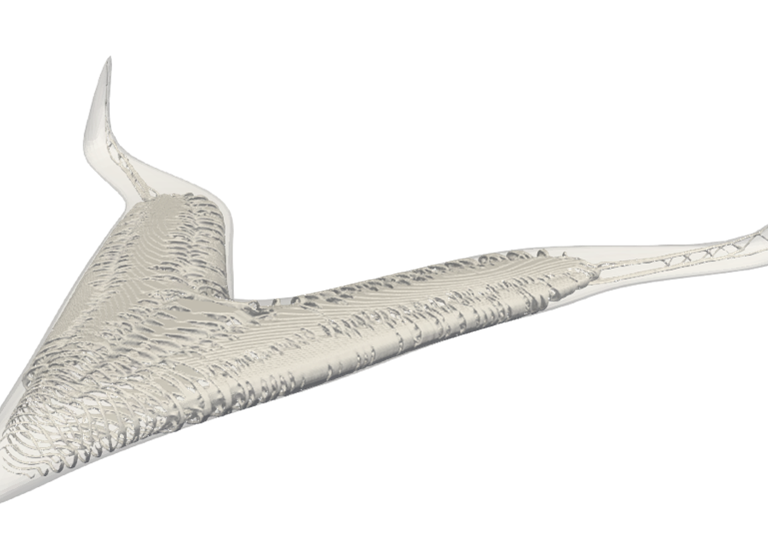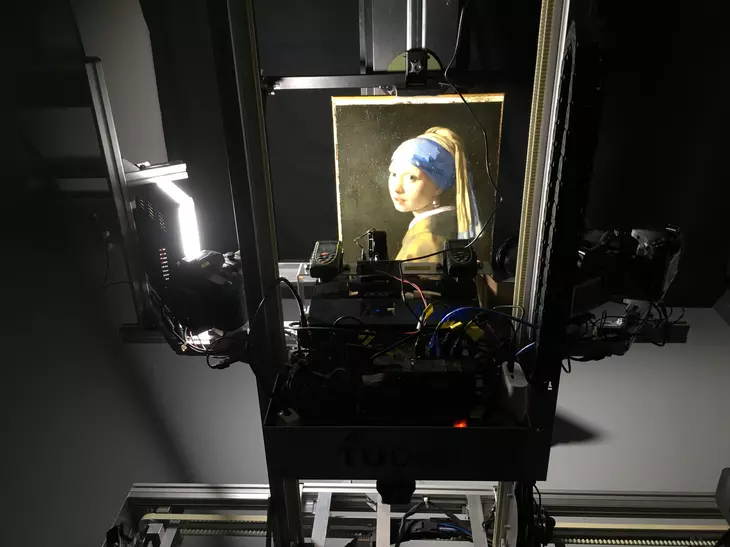
It’s all about the details: designing with the DHPC supercomputer
As of this January the Faculty of Industrial Design Engineering (IDE) has joined the Delft High Performance Computing Centre (DHPC) and the Delft Institute for Computational Science and Engineering. How can this ‘super (computing) power’ be used for design research, to advance visualisations, optimise 3-D printing techniques and solve societal issues and more? What effect could this have on the role of designers? What new areas of research could be addressed? And what implications could this have on ethical issues?
To explore the possibilities and investigate the implications for designers and our society, we interviewed Jun Wu, Jan Jaap van Assen and Caiseal Beardow.

What is the relevance of supercomputing for design and what role can design play in it?
HP will be transformed into a design material
Caiseal Beardow- PhD student focusing on exploring quantum human-computer interaction and developing new mental models of quantum computers to improve accessibility. Beardow indicates 'Precisely by applying it within the faculty of IDE and not, for example, in Computer Science, I suppose, it will not be considered just as a technical artefact or a means to an end, but a creative medium as well. Through application within IDE, because of our perspectives on technologies in relation to design contexts, HP can become more: it can be transformed into a 'design material' as opposed to purely a 'technical thing'. In addition, Beardow sees room to study quantum and supercomputing in their own right: "There’s real potential for symbiosis between these emerging technologies and the field of design—the value goes both ways.”
Supercomputing within IDE will make it a design material and not just a 'technical thing'.

From computer-aided design to generative design
Jun Wu is an Associate Professor of Computational Design and Fabrication at IDE. His research is focusing on computational design, design for additive manufacturing, and topology optimization. Jun Wu says the DHPC can play a critical role in computational design, allowing to design the optimal shape for products ranging from customized medical implants to lightweight aeroplane parts.
‘Computers are not just a digital sketchpad in product design. While product shapes are often manually sketched by designers, computer algorithms are being developed to generate the best-performing shapes. The idea is to develop and use computer algorithms to efficiently and accurately translating functional requirements into optimal shapes. The computation involved in generating the best design is very intensive, as the computer needs to analyse a huge number of alternatives and evaluate them based on all relevant criteria in order to come up with the best design.’ The DHPC can be used to accelerate the computation involved in generating and evaluating design solutions.

Jan Jaap van Assen who just finished a two-year Marie Skłodowska-Curie Individual Fellowship at the Perceptual Intelligence Lab of Delft University of Technology. At the π–Lab, he investigates the perception of collective flow - complex movement patterns of, for example, flocks of birds or crowds - using psychophysics, computer graphics, statistical modelling, and machine learning.
‘Design, design research, and the identity of design are challenged by the rapidly evolving information-driven societies we are transitioning into. Technological advancements in high performance computing, energy scavenging, digital connectivity, and (big) data accessibility have enabled the development of highly interconnected systems with various degrees of intelligence and greatly improved accessibility. These developments already have large impacts on our everyday lives and as system complexity increases, rising dynamic, emergent, and self-organizing qualities make design ever more challenging. These design challenges require new design tools and methods where computational infrastructure to facilitate these tools is key.’ Therefore, van Assen indicates, you should think of the supercomputer as a "workhorse, which can perform calculations for you in the background".
Design, design research, and the identity of design are challenged by the rapidly evolving information-driven societies we are transitioning into.
HPC @ IDE
Jan Jaap van Assen came to Delft on a two-year scholarship. At that time, the word “AI” was buzzing in all the corridors of the faculty. But what IDE lacked was a system that could for example properly train deep neural networks. Van Assen needed a system to train neural networks to simulate visual processes of the human brain. This is how Van Assen got to establishing the HPC @ IDE server and community. HPC @ IDE is a powerful server that can only be used within IDE faculty and a small community of designers using it. Since IDE joined DHPC in January 2023, much more computational capacity has become available for designers with experienced and knowledgeable potential partners across all faculties.

Caiseal Beardow
- C.R.Beardow@tudelft.nl
-
Room B-2-140

Jan Jaap van Assen
- +31 6 5761 7119
- j.j.r.vanassen@tudelft.nl
- Personal website
-
Room C-2-190
Present on: Mon-Tue-Wed-Thu-Fri

Not just for computational whiz kids
Kees Vuik, scientific director of DHPC and Frans Broos, ICT manager at EWI and TBM faculties, state:
DHPC is emphatically not just for computational whizkids or would-be programmers, but for all students. For example, we also want to help students working with big data. How many times have I been asked by graduating students whose laptops jammed on this? Then you still have to find a way to achieve results.
Future of HP computing and the role of designers
Jun Wu sees that: ‘With the ever-increasing computing power and intelligent algorithms being developed, generative design will become an integral part in the product design process.
The next step is human-centred generative design. Computers are very good at solving mathematical and physical problems. In product design, however, you also care about perception and acceptance. For example, aesthetics is not something computers can evaluate reliably. The computer-generated products may satisfy all functional requirements, but just not appeal to users. Can designers teach computers what beauty is?
On the one hand, teaching computers about beauty is super interesting. On the other hand, I don’t think computers will be able to take a holistic view as product designers do, even if someday computers can do aesthetic evaluation. We shall let computers do what they are good at, and find a way to let the designer engage with computer algorithms in order to co-create best products.
Algorithm-driven design will become an integral part in the product design process. It is important to engage the designer in algorithm-driven design and enable the designer to interact with the computing algorithm.
Jan Jaap van Assen: ‘Designers are not computer scientists, yet the design challenges of the future are increasingly relying on computational efforts. This presents challenges where the main hurdle for designers is the lack of insights and skills that are necessary to fully utilise HPC systems in support of design. Luckily, there are already many multidisciplinary designers from various fields (e.g., ergonomics, cognition, perception) who are with their feet in both worlds and can lead in these changes. I expect that acquiring programming and other computation-oriented skills over time will gain a more dominant role in the design curriculum or become available as a design specialisation making designers more future-proof for information-driven challenges. The demand and use of the HPC infrastructure will gradually increases with these trends.’
Role of the designer
What effect will HP computing have on the role of the designer? And how will this new technology be embedded into the design process.
Caiseal Beardow: “Personally, I think design has a very human quality to it: it combines both the intuitive and analytical aspects of our cognition... Here's a philosophical argument: Can a trained model exercise such intuition? I think of it as a very complex computation—often beyond feasible human understanding—but mediated by the person training the model. We see these technologies as partners in the design process, as collaborators.”
But there is also the process of figuring out what this collaboration really looks like. One current topic is the ethical relationship between generative models and the works of artists and designers. As designers, though, I think we are well prepared to deal with such complex situations. Now we need to think about the often-conflicting needs and goals of both human and more-than-human actors. Ultimately, I think it's important to recognize how relevant these complex technologies are to design—and to account for them in our practices.”

Application of quantum and high-performance computing in research and projects
The projects below are examples of the use of quantum or supercomputing. To give an idea of the possibilities offered by supercomputing.
Lightweight design of the Flying-V
In a project funded by the Delft Institute for Computational Science and engineering, Wu and colleagues from ME, EEMCS, and AE set the ambitious goal of creating a lightweight design of an entire aeroplane – the Flying-V.
The design is generated by a computer algorithm which works in a principle similar to how our bone reacts to mechanical loads. It places material only where it is necessary, and removes material where it is less relevant. Key in this algorithm is to evaluate where material is most needed. This requires discretizing the entire aeroplane into billions of voxels (i.e. similar to pixels, but in 3D), and doing finite element analysis to understand the stress distribution. Based on the analysis, the computer algorithm iteratively redistributes the material in the aeroplane, reducing its weight and improving its load bearing capacity. The involved computation is simply not possible on a desktop computer.
Image (right) credit: Arnoud Delissen (ME). DCSE funded project. A collaboration between IDE, ME, EEMCS and AE.
In a related previous project, Wu used this algorithm to design critical components in the flying-v cabin.
The higher resolution you design with, the better performance you get.
Jun Wu on using HP computing in designing the interior layout of a new aeroplane
More on Jun Wu’s work
Podcast Out of the Blue #21 – Generative Design
Conversation with Delft Design researcher Jun Wu about possible technological solutions using 3D printing for what he calls generative design: using algorithms to design functional and sustainable products:
https://podcasts.apple.com/nl/podcast/out-of-the-blue-21-generative-design/id1449263013?i=1000544640431

LANDSHAPES - Frederik Ueberschär (former IDE researcher)
The interactive installation LANDSHAPES lets artificial intelligence create non-existent satellite images of the Earth's surface. Humans can change those landscapes. In this way, Ueberschär aims to playfully engage them emotionally about climate change.

Alternative Algorithm - Vera van der Burg (PhD candidate)
Has a focus on artificial intelligence and how it can work in the world of design and art.
Alternative Algortithm is about what can an algorithm reveal about your relationship to the things around you?
- Her website
- Exhibtion at Dutch Design Week

FLOW - Jan Jaap van Assen
Examined two aspects of "flow":
- ‘Our Elemental Sense of Collective Flow’: this kind of collective movement occurs in both living and non-living systems at microscopic and macroscopic scales. In the movement patterns of these active matter systems, we can see leadership, agitation, discipline, coherence, and many other things despite the complexity of the patterns. How are we able to do this?
Click here for more information. - Motion consistency across materials: how does our visual system deal with changes in motion caused by optical variations in the scene. Here, we use neural networks and other biological models to investigate how we perform this visual task. Much of this research also relates to design, for example through affordance estimation, cognitive ergonomics and perception of materials or products.
Click here for more information.

3d fine art reproduction - Willemijn Elkhuizen
Is assistant professor at the Faculty of Industrial Design Engineering. Her main research interests are in material appearance capturing, visualization and fabrication (using 3D scanning and 3D printing) and their application in the domains of (product) design and cultural heritage.
Reproducing the material appearance of Fine Art artefacts using 3D scanning and 3D printing technology.
Creating lifelike reproductions of historical paintings using 3D scanning and 3D printing technology, as a step towards full control over material appearance (colour, gloss, texture and translucency) in 3D printing.
Click here for the Delft Design Story
